Introduction
Innovation has become increasingly important and determinant of organizational performance, success, and longer-term survival (Anderson, Potočnik and Zhou, 2014; Ramos, Anderson, Peiró, and Zijlstra, 2016). The dynamic and competitive environment, rapid changes in technology, high demands on new products and services, require organizations to develop new approaches that are more attractive to their stakeholders and respond effectively to the challenges they face.
The role that leadership plays in promoting innovation has been the subject of study over the last decade. Particularly, transformational leadership has been highlighted as one which supports the organizational innovation (Gumusluoglu and Ilsev, 2009a, 2009b; Jung, Chow, and Wu, 2008; Jung, Wu and Chow, 2003; Mumford, Scott, Gaddis, and Strange, 2002). Transformational leaders seek their followers to develop their own capacities and achieve exceptional results, their role being to stimulate, inspire and support the growth and development of their followers as leaders (Bass, 1999; Bass and Riggio, 2006). This type of leadership grants a sense of empowerment to its followers and aligns the individual, leader, group and organization’s interests and objectives. Transformational leadership has been conceptualized in four components: idealized influence, intellectual stimulation, inspirational motivation, and individualized consideration (Bass and Riggio, 2006). Nevertheless, some studies found only a unidimensional measure of transformational leadership (e.g. Gumusluoglu and Ilsev, 2009).
Another factor that plays an important role in innovation is the organizational culture (Jung, et al., 2003; Sarros, Cooper, and Santora, 2008). That is, the degree to which the members of an organization feel that the organization supports them and encourages them to take innovative initiatives and explore new approaches has an impact on the intensity of innovation in the organization (Amabile et al., 1996; Chandler, Keller and Lyon; 2000). Among the models of analysis of organizational culture is Denison’s organizational culture model (Denison, Nieminen, and Kotrba, 2014), whose dimensions inherent to the model have proved to be useful and valid for the process of diagnosis of organizational culture. The model proposes the existence of four dimensions: Involvement, Consistency, Adaptability and Mission. The Involvement dimension reflects how much the members of the organization are involved in the management process. The Consistency dimension reflects the sharing of core values, consensus and common goals and objectives among members at all levels of the organization. The Adaptability dimension refers to the ability of organizations to adapt quickly to changing their environment, taking risks, learning from their mistakes, and adding value to their customers, seeing their opportunities to survive and grow. The Mission dimension provides the organization with a strategic direction, purpose or design, which allows it to set its global goals, as well as expressing the vision of how it will be in the future, giving its members an appropriate course of action. All these traits were linked to organizational effectiveness; nevertheless, in the present study we will relate this model to organizational innovation.
As we pointed out, leadership and organizational culture play an essential role so that innovation can occur. However, just as Bass and Riggio (2006) advocate, leadership and culture are interconnected in such a way that organizational cultures can be described in terms of transformational qualities. So, we will explore the interrelation between these two constructs.
In turn, organizational innovation is a complex and multidimensional process (Wolfe, 1994). Some studies conceptualize innovation as a process that involves the generation of new or significantly improved ideas and their implementation (e.g. Amabile et al., 1996), as well as a process of creating value from ideas (Tidd and Bessant, 2014). The OECD (2005) recommends that companies can explore new products or services, business processes, work organization or marketing or improvements to existing ones in an innovative way. So, we consider innovation as a process that involves the creation of new ideas, or a significant improvement, and the implementation of these ideas in the products or services, business processes, work organization or marketing, that could benefit the company, its stakeholders and the society in general (Lousã, 2013). We use a set of innovation indicators developed by Lousã (2013), based on the academic literature (e.g. Scott and Bruce, 1994; Jung et al., 2003), on the Portuguese instruments such as the Innovation Scoring System (COTEC, 2017), as well as on expert interviews. The instrument has three dimensions concerning the companies’ activity oriented towards innovation, these are as follows: Resources, Processes and Results. Innovation resources aim to analyse the inputs for the organisation towards the activities for innovation, such as the resources available, the level of qualifications and the participation in lifelong learning activities of the human resources, investment/expenditures in Research and Development. The innovation processes aim to analyse relevant process to the innovative dynamic, such as partnerships, cooperation networks and protection and enhancement of knowledge. And finally, innovation results aim to evaluate the outcomes of the activities of a company, such as: the turnover in the last three years; the evolution of sales of new products / services or significant improvements over the last three years; the ideas generated in the company transformed into innovative designs and the enterprise image.
Based on the literature that analyses, on the one hand, the role of leadership in innovation and, on the other hand, the influence that culture has on innovation, we have developed an exploratory model that starts from the interdependence between culture and leadership and analyses the influence of this association in innovation. However, there is some empirical evidence that shows that company size is an important variable in the relationship between transformational leadership and organizational innovation (e.g. Vaccaro, Jansen, Van Den Bosch, and Volberda; 2012; Khan, Rehman and Fatima, 2009) as the organizational culture influences organizational innovation (e.g. Chandler et al., 2000). So, we propose in this study to analyse the effect that organizational culture and transformational leadership have on organizational innovation, taking into account the size of the company.
Method
Sample
The data were collected from 102 Portuguese organizations, among 854 workers. Regarding the dimension of the sample, there are 30.4% micro-enterprises, 38.2% small companies; 24.5% medium-sized companies and 5.9% large companies, according to the European classification. These percentages are close to the enterprises’ distribution in Portugal, since it is mainly made up of micro, small and medium enterprises. The age of the companies varies between two and 115 years (M = 18.98 years, SD = 18.97 years) and the employees per company range from two to 643 (M = 61.51 per company, SD = 114.86).
The company’s size was operationalized considering the number of employees in the company, and was categorized as: Micro (1-9 employees); Small (10-49 employees); Medium (50-249 employees) and Large (≥ 250 employees).
Measures
Organizational Culture Questionnaire
In the present study, we use the Organizational Culture Questionnaire Denison (Denison et al, 2014), consisting of 60 questions that measure four dimensions of organizational culture: involvement, consistency, adaptability and mission (α between .63 and .87). A Confirmatory Factor Analysis (CFA) showed a good fit, χ2/df = 3.22, CFI = .85, and RMSEA =.054 (CI. 90 between .052 and .055).
Transformational Leadership Scale
The items that make up this scale were inspired by the four components of transformational leadership developed by Bass (1985). The version used for this study is composed by 17 items. CFA showed an acceptable fit, CFI = .91, χ2/df = 5.61, and RMSEA =.08 (CI. 90 between .075 and .89). Reliability was very good (α = .96).
Innovation measurement
In the proposal of the exploratory model, we have identified the relational structures that are intended to be measured and we have chosen, in the case of innovative measures, the operationalizations that are best likely to represent the construct (Bollen, 1989; Hoyle, 1995, Loehlin, 1997), all of them being present in the innovation index from Table 1.
The calculation of the innovation index was performed from the standardization of the individual indicators and, subsequently, from their aggregation, from the sum of the different standardized individual indicators, obtaining a “z-Score” without weighting.
Table 1: Measures and operationalization of Innovation
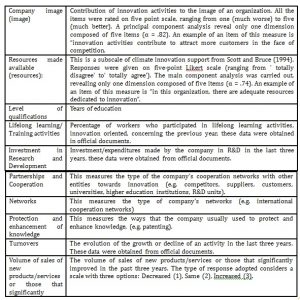
Procedures
The data used in the present study were collected taking into account ethical issues such as participants’ anonymity and confidentiality, and also to avoid bias. After having agreed to participate, the top management of each organization was asked about the innovation activity at their organization through a questionnaire. Each of them was instructed about the objectives and procedures of the internet-based study via e-mail or telephone. Anonymous and strictly confidential data treatment was assured. Due to the level at which the top management operates, we expected that they were knowledgeable regarding the resources, processes and results of the innovation of their organizations. The measures of leadership and organizational culture, in each firm, were answered by a representative sample of employees, based on the organization, their distribution at the organizational structure and the departments involved.
Data Analysis
All the analyses were completed using the statistical program SPSS and AMOS 22.0 for Windows. Outliers were analysed according to Mahalanobis squared distance (Tabachnick and Fidell, 2013), and were excluded.
CFA was performed with AMOS (v. 22.0; Arbuckle, 2013), with maximum likelihood as the estimation method (Jöreskog and Sörbom, 2004). Goodness of fit was analyzed by the following indices: NFI (Normed of fit index; good fit is considered if NFI > .80; Schumacker and Lomax, 2010), CFI (Comparative fit index; good fit if CFI > .90; Bentler 1990), RMSEA (Root Mean Square Error of Approximation; acceptable fit if RMSEA < .08 according to Kline, 2011, and Schumacker and Lomax, 2010, although according to Marôco, 2011, acceptable fit is considered if RMSEA < .10), and X2/df (chi-square/degrees of freedom; acceptable fit if X2/df < 5; Arbuckle, 2013; Loehlin, 2004). According to Bentler (1990), and Schumacker and Lomax (2010), X2 is irrelevant for samples higher than 500 subjects.
Results
Both measures of Leadership, Innovation and Culture (and the corresponding dimensions) were analyzed concerning the descriptive statistics (see Table 2). Correlations between all measures were presented in Table 3. Leadership showed, according to Cohen (1988), a moderate correlation with Innovation (r = .33) and with Culture as a total score (r = .45); the association between Innovation and Culture was small (r = .183).
Table 2: Descriptive statistics of Measures of Leadership, Innovation, and Culture and their dimensions
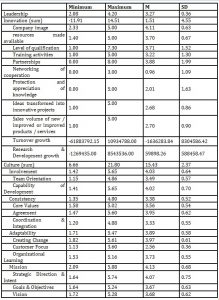
Table 3: Intercorrelation matrix of measures of Leadership, Innovation, and Culture and their dimensions
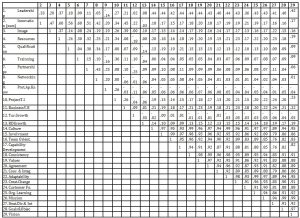
Legend: Company image (image); resources made available (resources); level of qualification (qualification); training activities (Training); partnerships (partnerships); networks of cooperation (networking); protection and appreciation of knowledge (Prot.Ap.Know); ideas transformed into innovative projects (I.T. Project); sales volume of new / improved or improved products / services (Business V.E); turnover growth (Turn. Growth); Research & Development growth (R&D growth); Team Orientation (Team Orient.); Capability Development (Cap.Develop.); Coordination & Integration (Coor. & Integ); Creating Change (Creat.Change); Customer Focus (Customer Fo.); Organizational Learning (Org. Learning); Strategic Direction & Intent (Strat.Dir.& Int); Goals & Objectives (Goals&Objec).
Note: r >.08 are significant at p < .05; .10 < r < .30 have a small effect size, 30 < r < .50 have a medium effect size; r > .50 have a large effect size (Cohen, 1988).
A structural model was established and the measurement model was specified according to literature (Byrne, 2010; Schumacker and Lomax, 2010), considering micro and small enterprises in one model (n = 464 see Figure 1, unconstrained model) and the medium and large enterprises in another model (n = 385; see Figure 2, unconstrained model) tested by multi-group analysis. The results showed a good fit considering NFI = .858 and an acceptable fit for CFI = .874 and RMSEA=.087 (CI .90 between .085 and .090). The score obtained for CMIN/DF (448) was 7.43, p < .001.
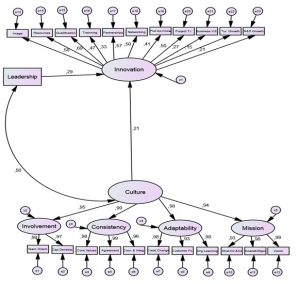
Legend: Company image (image); resources made available (resources); level of qualification (qualification); training activities (Training); partnerships (partnerships); networks of cooperation (networking); protection and appreciation of knowledge (Prot.Ap.Know); ideas transformed into innovative projects (I.T. Project); sales volume of new / improved or improved products / services (Business V.E); turnover growth (Turn. Growth); Research & Development growth (R&D growth); Team Orientation (Team Orient.); Capability Development (Cap.Develop.); Coordination & Integration (Coor. & Integ); Creating Change (Creat.Change); Customer Focus (Customer Fo.); Organizational Learning (Org. Learning); Strategic Direction & Intent (Strat.Dir.& Int); Goals & Objectives (Goals&Objec).
Fig. 1: Innovation predicted by organizational culture and leadership in Micro and Small Enterprises: Standardized regression coefficients
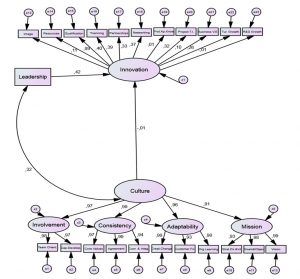
Legend: Company image (image); resources made available (resources); level of qualification (qualification); training activities (Training); partnerships (partnerships); networks of cooperation (networking); protection and appreciation of knowledge (Prot.Ap.Know); ideas transformed into innovative projects (I.T. Project); sales volume of new / improved or improved products / services (Business V.E); turnover growth (Turn. Growth); Research & Development growth (R&D growth); Team Orientation (Team Orient.); Capability Development (Cap.Develop.); Coordination & Integration (Coor. & Integ); Creating Change (Creat.Change); Customer Focus (Customer Fo.); Organizational Learning (Org. Learning); Strategic Direction & Intent (Strat.Dir.& Int); Goals & Objectives (Goals&Objec).
Fig. 2: Innovation predicted by organizational culture and leadership in Medium and Large Enterprises: Standardized regression coefficients
Analyzing the two models resulting from the structural analysis, we found very significant differences, which lead us to conclude the moderation effect of the company size variable. In the multiple regression coefficient of the direct determination of culture for innovation, we find that it is significant in micro and small firms (β = .21), while it is null in medium and large firms (β = -.01). Thus, the size of the organization is a factor that must be taken into account when analysing the effects of culture and its impact on innovation. In micro and small companies, culture has a direct impact on innovation. In the case of medium and large companies, culture only has an effect on innovation through intervention of the leader. In these larger companies, the leader is fundamental in the way culture promotes innovation. In micro and small companies, the role of the leader is also important, and, also, there is a direct influence of organizational culture on the promotion of innovation, as well as the combined effect of transformational leadership and culture on innovation.
Comparing between the two models of the simple regression coefficients, we found that in micro and small companies all indicators of innovation are significant in the promotion of it. However, in the medium and large companies, the variables protection and valorisation of knowledge, growth in R & D and the evolution of turnover are insignificant. It should also be noted that in companies of all sizes we find a negative effect of the growth of turnover in promoting innovation.
Discussion/Conclusion
The proposed structural model showed that the variable size of the company acts as a moderator, producing differential effects not only on the leadership role in the relationship between culture and innovation, but also on the contribution of each indicator to innovation. In this sense, the present study contributes to a better understanding of the effects of company’s size on the relationships between leadership, culture and innovation.
The present study showed that, in smaller companies, the organization’s culture is more directly associated with innovation, with a greater impact on innovative processes, resources and results. In this type of companies, we have verified that the leader acts together with the culture in the promotion of innovation, with the evident impact of both in the processes and the results of the innovation. Regarding innovation indicators, it is clear that in micro and small companies; the contribution is stronger and positive in the processes (e.g. networks, qualification, protection and valorisation of knowledge) and results (e.g. image and ideas transformed into projects innovators). This result is consistent with Chandler et al, (2000) which found that companies with cultures supportive of innovation tend to be smaller.
In comparative terms, we found that the organizational culture does not have direct effects on innovation in the larger companies, and the role of the leader in the promotion of innovation is fundamental. In this type of companies, the contribution of innovation indicators is more focused on the resources made available. Although other contributions (e.g. human resources qualification, cooperation networks, partnerships, participation in training activity, ideas transformed into innovative projects) are visible, they have a smaller influence in determining innovation compared to micro and small enterprises. These results are consistent with Vaccaro et al. (2012), which show that larger organizations need more of a transformational leadership to compensate for their complexity and allow innovation to occur. Also, as Damanpour and Schneider (2006) point out, larger organizations can dedicate more resources to innovation activity, and top managers play an important role in allocating these resources. They are also consistent with Khan et al., (2009; p.683), which point out the role of the transformational leadership and their dynamic capabilities to enhance organizational innovation in organizations with larger size and with ample resources.
The major contribution of the present study for the existing literature is that leadership should focus on developing a conductive culture that facilitates and promotes innovation, in other words, in an innovation-driven culture.
Limitations
In the present study we found that some indicators of innovation are important in one situation and less important in others. Growth indicators, on the other hand, were not influential. This aspect should be considered with some caution. If, on the one hand, these growth indicators may not reflect the company’s ability to focus its activity on innovation, then, we should not be oblivious to the fact that a large number of the companies that make up our sample have not invested in research and development over the past three years, and even those that have done so have not shown very significant increases in their activities over the last three years. It may also occur, such as Jung et al. (2003) suggest that this measure reflects the desire of companies to support innovation efforts, but that this is not turned into processes or results, at least from a short-term perspective. Also at the level of the variable turnover growth, we find that its contribution to innovation is negative. In fact, as previously noted, a decrease in sales volume in the last three years of the companies’ lives was evident, reflecting the situation of crisis that, in recent years, affected most Portuguese companies. This will undoubtedly be a promising area for future research.
Acknowledgment
We thank A. Duarte Gomes, University of Coimbra, Faculty of Psychology and Education Sciences, Portugal, for the guidance provided in the present study.
(adsbygoogle = window.adsbygoogle || []).push({});
References
- Amablie, T. M., Conti, R., Coon, H., Lazenby, J., and Herron, M. (1996), ‘Assessing the work environment for creativity’, Academy of Management Journal, 39 (5), 1154-1184.
- Anderson, N., Potocnik, K., and Zhou, J. (2014), ‘ Innovation and Creativity in Organizations: A State-of-the Science Review and Prospective Commentary’, Journal of Management, 40(5), 1297-1333.
- Arbuckle, J. L. (2013), Amos 22 user’s guide, Chicago, IL: SPSS.
- Bass, B. M. (1999), ‘Two decades of research and development in transformational leadership’, European Journal of Work and Organizational Psychology, 8 (1), 9-32.
- Bass, B. M., and Riggio, R. E. (2006), Transformational leadership (2 ed.), Mahwah, NJ: Lawrence Erlbaum.
- Bentler, P. (1990), ‘Quantitative methods in psychology: Comparative fit indexes in structural models’, Psychological Bulletin, 107, 238-246.
- Bollen, K.A. (1989), Structural equations with latent variables, New York: Wiley.
- Byrne, B. M. (2010), Structural equation modeling with AMOS: Basic concepts, applications and programming (2nd ed.). London: Lawrence Erlbaum.
- Chandler, G. N., Keller, C., and Lyon, D. W. (2000), ‘Unravelling the determinants and consequences of an innovation-supportive organizational culture’ Entrepreneurship Theory and Practice, 25 (1), 59-76.
- Cohen, J. (1988), Statistical power analysis for the behavioural sciences (2nd ed.), New York: Academic Press.
- Portugal (Maio, 2017), Innovation scoring. manual de apoio ao preenchimento do sistema innovation scoring da cotec, Cotec Portugal, Associação empresarial para a inovação.
- Damanpour, F., and Schneider, M. (2006), ‘Phases of the adoption of innovation in organizations: Effects of environment, organization and top managers’, British Journal of Management, 17 (3), 215–236.
- Denison, D., Nieminen, L. and Kotrba, L. (2014), ‘Diagnosing organizational cultures: A conceptual and empirical review of culture effectiveness surveys’, European Journal of Work and Organizational Psychology, 23 (1), 145-161.
- Gumusluoglu, L., and Ilsev, A. (2009), ‘Transformational leadership, creativity, and organizational innovation’, Journal of Business Research, 62, 461-473.
- Hoyle, R. (1995), Structural equation modeling: Concepts, issues, and applications, Thousand Oaks, CA: Sage Publications.
- Jöreskog, K. G., and Sörbom, D. (1996). LISREL 8: User’s reference guide. Chicago: Scientific Software International.
- Jung, D. I., Chow, C., and Wu, A. (2003), ‘The Role of Transformational Leadership in Enhancing Organizational Innovation: Hypotheses and Some Preliminary Findings’, Leadership Quarterly, 14, 525–544.
- Jung, D. I., Wu, A., and Chow, C. (2008), ‘Towards understanding the direct and indirect effects of CEOs’ transformational leadership on firm Innovation’, Leadership Quarterly, 19, 582–594.
- Khan, R.; Rehman, A. U. and Fatima, A. (2009), ‘Transformational leadership and organizational innovation: Moderated by organizational size’, African Journal of Business Management, 3 (11), pp. 678-684.
- Kline, R. (2011), Principles and practice of structural equation modeling (3ª ed.), New York: The Guilford Press.
- Loehlin, J. C. (1997), Latent variable models, Mahwah, NJ: Lawrence Erlbaum Associates.
- Lousã, E. P. (2013), Liderança empreendedora e cultura de inovação em organizações de base tecnológica e análise comparativa entre setores de atividade, A Dissertation submitted in fulfillment of the requirements of the doctor of philosophy, University of Coimbra, Faculty of Psychology and Education Sciences, Portugal.
- Marôco, J. (2011), Análise de equações estruturais: Fundamentos teóricos, software & aplicações, Pêro Pinheiro: Report Number.
- Mumford, M. D., Scott, G. M., Gladdis, B., and Strange, J. M. (2002), ‘Leading creative people: orchestrating expertise and relationships’, Leadership Quarterly, 13, 705-750.
- (2005), Oslo Manual: Guidelines for collecting and Interpreting Innovation Data, Paris: Organisation for Economic Co-operation and Development.
- Ramos, J., Anderson, N., Peiró, J. M., and Zijlstra, F. (2016), ‘Studying innovation in organizations: a dialectic perspective – introduction to the special issue’, European Journal of Work and Organizational Psychology, 25(4), 477–480.
- Schumacker, R. E., and Lomax, R. G. (2010), A beginner’s guide to structural equation modeling (3rd ed.), Mahwah, N.J.: Lawrence Erlbaum Associates.
- Scott, S. G., and Bruce, R. A. (1994), ‘Determinants of innovative behavior: a path model of individual innovation in the workplace’, Academy of Management Journal, 37, 580−607.
- Tabachnick, B. G., and Fidell, L. S. (2013), Using multivariate statistics (6th ed.), New Jersey: Pearson Education.
- Tidd, J. and Bessant, J. (2014), Strategic Innovation Management, Chichester: John Wiley.
- Vaccaro, I. G., Jansen, J. J., Van Den Bosch, F. A., and Volberda, H. W. (2012 January), ‘Management Innovation and Leadership: The Moderating Role of Organizational Size’, Journal of Management Studies, 49 (1), 28-51.
- Wolfe, R. (1994), ‘Organizational innovation: Review, critique and suggested research directions’, Journal of Management Studies, 31, 405-431.







